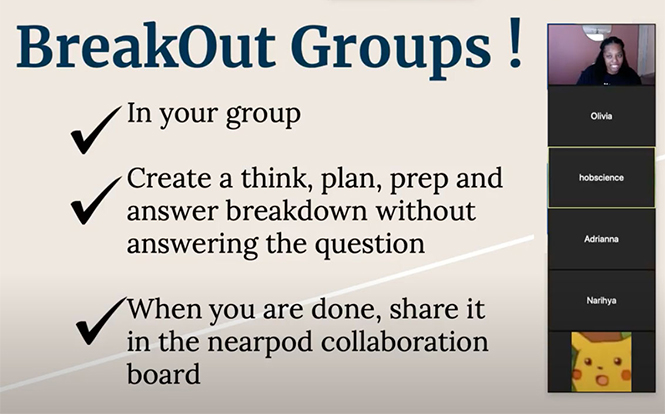As No-Nonsense Nurturers, we know the power of scholar discussion and discourse. In the current virtual world, we also understand that many of the platforms we are using offer an opportunity to provide space for structured scholars conversation. In many respects, the way a No-Nonsense Nurturer uses the Think Pair Share strategy can be adapted in the virtual setting for the same powerful impact.
In this blog, we’ll outline the best practices and some video examples for maximizing Zoom breakout rooms to set purpose and direction for a key question, plan for meaningful scholar groups, monitor and support groups in action, and then facilitate a full group share. Thank you to Ms. Newton, an 8th grade Math teacher at Ashley Park PreK-8 School in Charlotte, NC for providing two examples in providing directions and facilitating the share from her own virtual classroom this month!
Breakout Room Planning
- Plan for a question or task that allows scholars to engage with one another meaningfully and build a strong answer.
- Ensure the question or task is aligned to the learning objective, high rigor, and appropriately challenging given the content already provided to scholars.
- Determine if you’ll use random or planned groups.
- You may additionally plan for “group leaders” if necessary or needed. This allows for scholar leadership opportunity, and also ensures those scholars are trained on how to leverage a PPT or a tool to note-take.
- Plan for your “teacher pathway”.
- Determine which groups you will go to in order to monitor their thinking and discussion.
- Determine which groups you’ll go to first when considering who might need more support to get started.
Providing Strong Directions for Breakout Rooms
- Give purpose.
- Tell scholars why peer discussion in breakout rooms matter to their virtual learning
- Tell scholars why peer discussion supports their learning objective for the day.
- Provide a precise direction for thinking independently about the question or task first. This is the equivalent to “think time” before pairing and sharing.
- Provide the precise directions for what scholars need to do for the breakout session:
- Review the question or task they are considering in groups that they just thought about independently. Ensure this is visual for them.
- Provide a time expectation.
- Check for Understanding (CFU) to confirm they are clear.
- Cold Call scholars to repeat direction components.
- Provide space for scholars to restate and build on directions.
- Provide expectations for accountability when back with the full group.
- Some options may include:
- Collecting answers in private or public chat
- Cold calling based on the data you’ll collect
- Designating a group member ahead of time to present the group. This is particularly helpful when you’ve also assigned roles to each group.
- Some options may include:
In Ms. Newton’s example at minutes 0:00-3:56, she provides the question, clear expectations for time, what groups will do, and how they’ll be held accountable to their answers (i.e. in a private chat) after they are done. She then clarifies her directions, and checks for understanding with multiple scholars. When a scholar isn’t sure and can’t hear, she leverages another scholar to clarify. Please note: scholars were directed to turn off cameras to ensure privacy for this blog; otherwise, cameras turned on is generally a best practice in the virtual space otherwise.
Monitoring and Supporting During Breakout Rooms
- Determine what prompts you will give as you drop into breakout rooms.
- Determine what data you’ll collect.
- Consider the key points you are looking to hear and see, and track what you’re noticing on a piece of paper or notepad on your own device.
- Use this data to notate particular scholars you want to call on during the full group share.
- Consider what messages, reminders, or time checks will you want to broadcast during breakout. Note: Zoom allows you to broadcast into each breakout room, which is a very helpful tool that saves you time and supports scholar efficiency while working with one another.
Facilitating Full Group Share After Breakout Rooms
- Provide a precise direction for how the full group will review and discuss.
- Include what to do if called on (e.g., unmute, share response from group)
- Include what to do when listening (e.g., on mute, think about whether you agree or disagree with scholar who is sharing)
- Use the data you collected from the chat or elsewhere to determine what level of full group remediation or review is needed, and begin your cold calling accordingly.
- Ensure you stamp the key point or key learning before moving on in the lesson.
In Ms. Newton’s debrief part I and debrief part II, she leverages data from the chat to determine what her scholars need, which is a thorough review of the Think/Plan/Prep before they can Answer. She cold calls students from each group to share what they put into specific boxes. She leverages their answers to fill out the boxes full group, and probes the scholars she cold calls to give more clarity and rationale for their answers.
By Teshira Newton, 8th Grade Math Teacher at Ashley Park PreK-8 School, Alex Price, MCL at Ashley Park PreK-8 School, Meaghan Loftus and Joey Roane, Associates, CT3 Education
Category: Featured Educators, No-Nonsense Nurturer, Teaching


